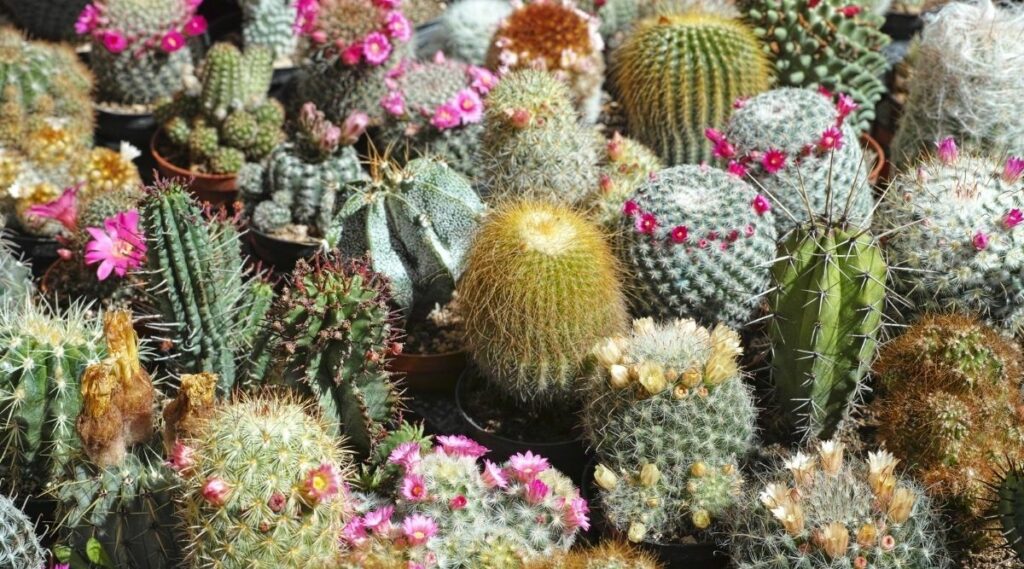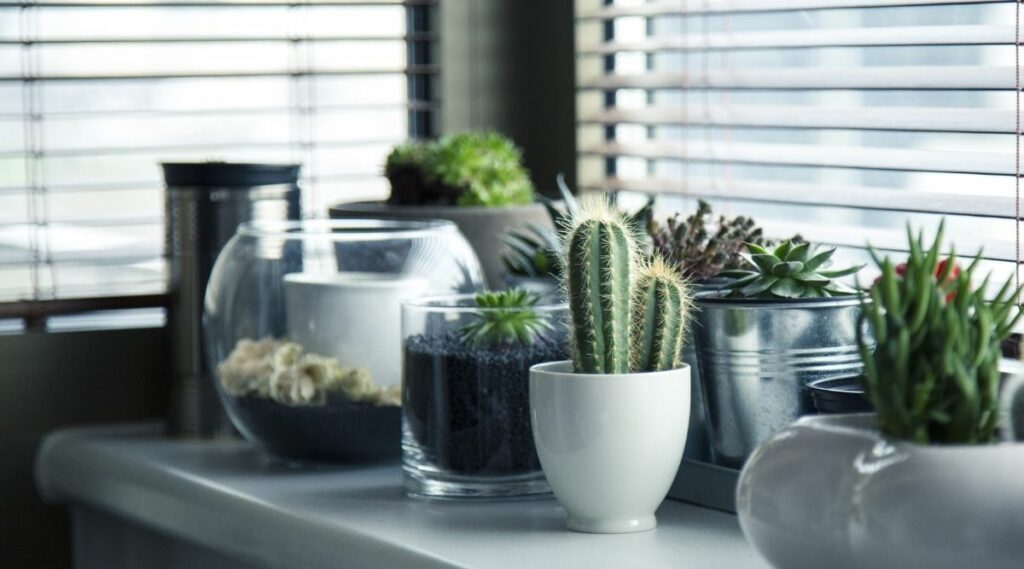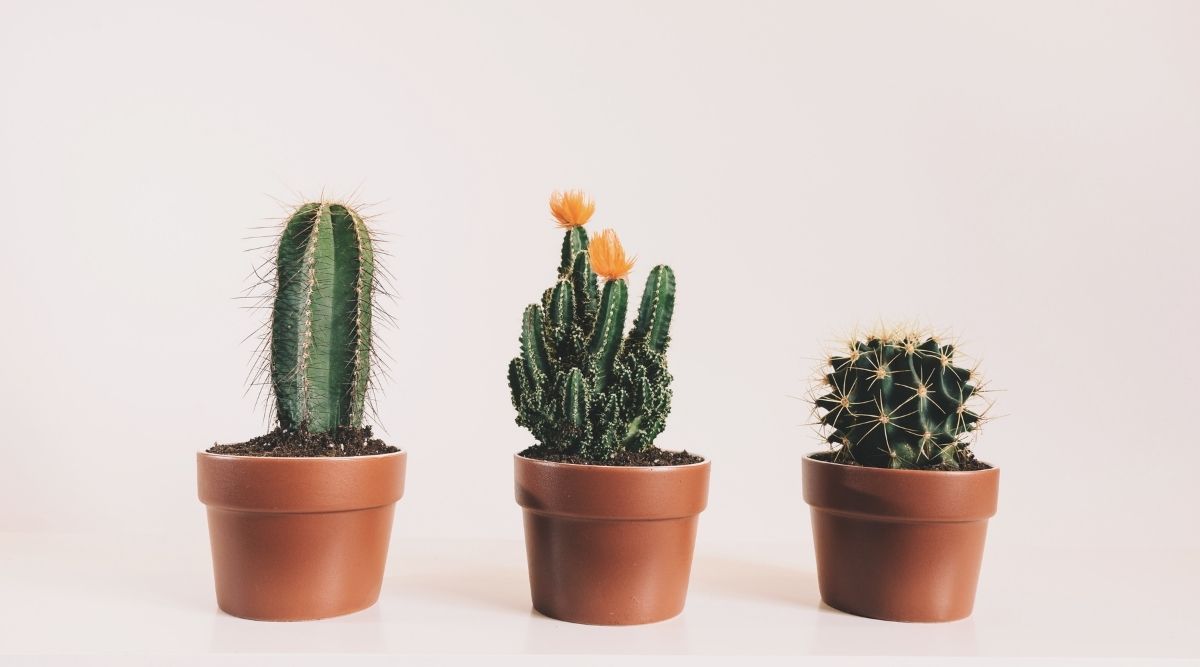Cacti are a tough and robust type of plant with thick skin and protective, sharp spines that make for great ‘plant pets’!
They can live both outdoors and indoors and in a wide variety of different shapes and sizes, grown both domestically and in the wild. They are truly unique plants with over 1500 species of different appearances.
A cactus is a popular choice for those who collect plants and succulents because of their one-of-a-kind looks and because they do not require a huge amount of attention. They are very durable and can live for a very long time and in a range of different temperatures.
The name ‘cactus’ was derived from the Greek word ‘Kaktus’ – which means an unidentified spiky plant, which is exactly what a cactus is!
Group cacti plants are most commonly found in parts of the US, UK, Canada, and Asia, as well as other parts around the world. Most species of cactus are succulents, which are identified by having thick leaves with a jelly-like center, and all cactus have spikes.

Cactus are incredibly well adapted to living in dry areas because they are Xerophytes, which means that they are resistant to shortages of water and mild droughts. But how long can they live for?
Well, it depends on several factors. For example, the growing conditions, the species, and nature can all affect how long a cactus will live. Cactuses generally live for a much longer time than any other plants, sometimes even up to 200 years!
That is longer than us humans live – imagine being outlived by your plant!
How Long Do Cactus Live Indoors?
Indoor cacti generally have a much shorter lifespan than when they live outside. However, they still live for around 10 years. It mostly depends on the state of care the cactus receives, and how well it is looked after.
Some may live a lot longer, whereas others may only live a few short months. Alongside how the plant is taken care of, different species of cactus also have different lifespans.
Factors like soil, water, and sunlight will affect your cactus plant and how long it will live. Much like humans, you will be able to see your cactus plant age over the years. Any damage or blemishes that it receives during its life will stay with them forever.
Things that could cause a cactus physical harm is too much sunlight, which would cause scorching and permanent blemishes on the plant. This doesn’t mean that your cactus would die necessarily, it just lowers the value of its cosmetic appearance.
Sometimes, a cactus will break under its weight, however, the fallen stems can root and regrow into a new plant, continuing the lifeline of your specific cactus.
How Long Do Cacti Live Outdoors?
In the outdoors, especially the wild, cactus plants live for much longer – sometimes even up to 200 years! This is because they are in their natural habitat where they know how to survive, look after and defend themselves.
Indoor cactus plants rely solely on you to provide for their needs. Another factor to consider is the species of cactus, as each has different lifespans.
The longest ever recorded living cactus was thought to be 300 years old when it died.
It was of the Saguaro species and died from a bacterial infection – how crazy is that? Not only do wild cacti live for so long, but they can also grow as tall as 60 to 70 feet in height.
The prickly pear cactus is an outdoor plant that doesn’t live as long as its relatives.
This is because it is a favorite for lizards and other animals to snack on the sweet fruits they produce during their growing season.
How To Ensure Your Cactus Has A Long Life

If you are looking to purchase your cactus or have one already, many tips will help you prolong the life of your plant. These things will help the plant live a long and happy life for many, many years to follow.
An indoor environment is artificial meaning the cacti are completely reliant on you for their needs. The best thing to do is research the species of your cactus to see if there are any specifics when it comes to their basic requirements such as soil, water, and sunlight.
Watering Your Cactus – Overwatering your cactus may cause them to become unhealthy, so it is important only to water them when they need it.
The amount of water they need will vary throughout the year and also depend on the soil they are in. It is important that your cactus plant is in well-draining soil and that it is in a pot with drainage holes for the excess water.
You should never waterlog the roots of your plant.
During the colder months of the year, your cactus isn’t going to need to be as watered as much as it does when it is warmer. If you overwater your cactus in the winter it may cause it to die because the water may end up freezing inside of it.
Sunlight – Cactus plants love sunlight, but too much of it can be damaging to them. Naturally, they live in hot deserts and so they need the sun to survive, thus you should always put them in the brightest spot of your house.
Even though the plants love the sun, you should always monitor your indoor cacti very closely because they can get burned from the sunlight through the window.
Type of Soil – The correct type of soil for your cactus plant should be coarse and sandy and should not retain water or stay damp.
You can create this type of soil by mixing sand, perlite, and potting soil or by purchasing a specialized mix for succulent plants that you can find in your local garden store.
Heat – Cold weather may prevent your cactus from growing and even cause them to become unwell and die. In their natural habitat, they are in constant sunlight and heat, meaning that they need warmth to survive.
If it drops below 35 degrees Fahrenheit, you should consider moving your plant to a warmer spot. The ideal temperature for cactuses is between 40 and degrees Fahrenheit.
Final Thoughts
As we have discussed, there are a variety of conditions that change how long a cactus can live.
Most of the time it will change from species to species, but always remember that looking after your cactus properly will expand its lifetime.
Using the correct soil mix and making sure that your cactus gets the right amount of sunlight and water will help to provide a happy and fulfilling life for your green friend!
- Best Hanging Plant For Low Light - September 4, 2023
- Best Indoor Plants Florida - August 28, 2023
- Best Plants For Bathroom Smells - August 21, 2023








